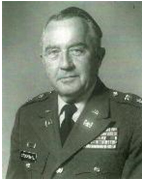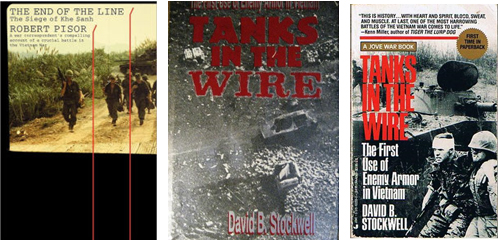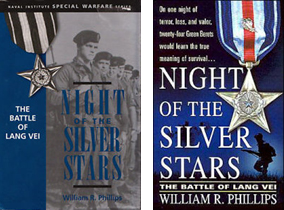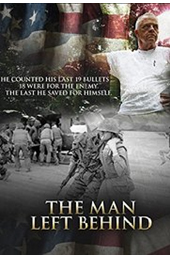The Book’s Journey
I didn’t serve in Vietnam and never traveled there. I neither served in Special Forces nor piloted an aircraft. That makes me a complete outsider to the story of Lang Vei (pronounced long vay) and probably the most unlikely candidate to tell it.
 My late father, Harvey, served as a US Army combat engineer officer in World War II and the Korean War and was an adviser in Vietnam from 1960 to 1961 when I was in the first grade. I grew up on slide shows and stories of Vietnam long before the war started. He described a leather map of Khe Sanh he acquired and passed up his chain of command. That image inspired the map on this book’s cover. When the war began, I followed it on dinner-time news broadcasts like many households across America, even as a child, due to my personal connection through my dad. I was in the eighth grade when the battle for Lang Vei occurred and remember it made news.
My late father, Harvey, served as a US Army combat engineer officer in World War II and the Korean War and was an adviser in Vietnam from 1960 to 1961 when I was in the first grade. I grew up on slide shows and stories of Vietnam long before the war started. He described a leather map of Khe Sanh he acquired and passed up his chain of command. That image inspired the map on this book’s cover. When the war began, I followed it on dinner-time news broadcasts like many households across America, even as a child, due to my personal connection through my dad. I was in the eighth grade when the battle for Lang Vei occurred and remember it made news.
Fifteen years later, I was a prior-enlisted army lieutenant in a cavalry (armored) unit at Fort Hood, Texas, when I read Robert Pisor’s book, The End of the Line: The Siege of Khe Sanh, in which he detailed that NVA tank attack on Lang Vei and reminded me it happened. I recall thinking, “I have to get the book on Lang Vei.” I was surprised to learn there was none, so I wrote my own, titled Tanks in the Wire: The First Use of Enemy Armor in Vietnam, published in hardback in 1989 and paperback in 1990.
 It wasn’t a very good book. More precisely, it didn’t honor the men who fought there in the manner they deserved and in the way I intended.
It wasn’t a very good book. More precisely, it didn’t honor the men who fought there in the manner they deserved and in the way I intended.
Bill Phillips wrote his book about Lang Vei, Night of the Silver Stars, published in 1997 to good reviews and achieved a significant measure of popularity. His connection to Lang Vei was personal. His cousin, Daniel Phillips, is still missing in action from Lang Vei.
 Fast-forward to 2014. I’d long since retired from the US Army and used the Internet to see who might have finally written the full story of the battle for Lang Vei, which meant including all the aviators and extraction force. Surprised to learn it didn’t exist, despite so many books written by veterans of that war, I sought once more to fill that missing slice of history.
Fast-forward to 2014. I’d long since retired from the US Army and used the Internet to see who might have finally written the full story of the battle for Lang Vei, which meant including all the aviators and extraction force. Surprised to learn it didn’t exist, despite so many books written by veterans of that war, I sought once more to fill that missing slice of history.
I called Paul Longgrear on the phone, reconnecting after nearly thirty years. He invited me to Dalton State College in Georgia to attend his presentation on Lang Vei to Professor Thomas Veve’s history class, and Paul shared with me copies of documents on the battle translated from Vietnamese he’d acquired in the intervening years. After that, I contacted Bill Phillips to propose the idea that I combine Tanks in the Wire with Night of the Silver Stars and any new interviews I could get. He gave me the nod, and with Paul’s encouragement, the Lang Vei Project began.
Paul opened lots of doors to survivors of the battle I hadn’t met. Key among them was Dennis Thompson, who opened even more doors for interviews and shared his invaluable research on the battle with me. More thanks to many others are detailed in the acknowledgements section of this book.
 Until this point, most of the interviews I or anyone else had done for projects on Lang Vei were largely limited to the men in the Lang Vei camp that night. Everyone else who fought—the marine artillery that fired from nearby Khe Sanh, the air force FACs who coordinated airstrikes, the navy pilots who delivered those decisive airstrikes, or the marine pilots who flew the army Green Berets and their indigenous troops in helicopters to extract the survivors under heavy enemy fire—was generally nameless and faceless.
Until this point, most of the interviews I or anyone else had done for projects on Lang Vei were largely limited to the men in the Lang Vei camp that night. Everyone else who fought—the marine artillery that fired from nearby Khe Sanh, the air force FACs who coordinated airstrikes, the navy pilots who delivered those decisive airstrikes, or the marine pilots who flew the army Green Berets and their indigenous troops in helicopters to extract the survivors under heavy enemy fire—was generally nameless and faceless.
All that changed at the Denver reunion in 2009 where men from the ground finally met the men from the air and recorded their meeting. Viewing those six hours of DVD recordings, Paul’s Vietnamese documents, and Dennis’s detailed research was the genesis of the Route 9 Problem.
 The 2009 Lang Vei reunion in Denver finally brought together the ground and air warriors. The late William “Speed” Ritzmann, connected with Richard Allen’s superb Lang Vei website and created the genesis of the reunion. Viewing the DVDs of that reunion was key to this story.
The 2009 Lang Vei reunion in Denver finally brought together the ground and air warriors. The late William “Speed” Ritzmann, connected with Richard Allen’s superb Lang Vei website and created the genesis of the reunion. Viewing the DVDs of that reunion was key to this story.
The magic of the Internet helped connect me with these previously unknown warriors or their surviving families through email and over the phone during the course of more than a year. That’s when the story broadened from solely Special Forces to a rare army, navy, air force, marine, and MIA family tale. If Tanks in the Wire was the story of Lang Vei 1.0, Route 9 Problem became the story of Lang Vei 5.0 for those reasons.
 The focus of the story also changed. It’s not a battle analysis or after-action report. It’s a story, written plainly for today’s young adults with no military experience to understand the war their fathers or grandfathers won’t discuss. It’s devoid of profanity for that reason, and all military jargon is fully explained, yet it’s a story to which veterans will relate. In 2012, Paul Longgrear’s dramatic conversion to Christianity during the battle for Lang Vei was captured in Christus Films’ masterful documentary The Man Left Behind.
The focus of the story also changed. It’s not a battle analysis or after-action report. It’s a story, written plainly for today’s young adults with no military experience to understand the war their fathers or grandfathers won’t discuss. It’s devoid of profanity for that reason, and all military jargon is fully explained, yet it’s a story to which veterans will relate. In 2012, Paul Longgrear’s dramatic conversion to Christianity during the battle for Lang Vei was captured in Christus Films’ masterful documentary The Man Left Behind.
A word about the photos used in this book. Many are fifty years old, so the quality of their reproduction here may not translate well. Nevertheless, I felt it important to use photos the men took and contributed, not only to help illustrate the story but also to add their considerable authenticity.
I still don’t consider myself much of an author; I’m just fortunate that all these incredible people trusted me to tell their story in full, or at least to provide as full an accounting as I was able. I hope I do them justice in these pages and that you grow to honor and love them as much as I do. I alone am responsible for any flaws in the following pages. They are the real deal.
